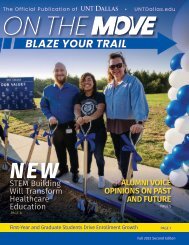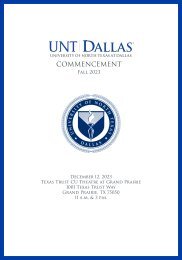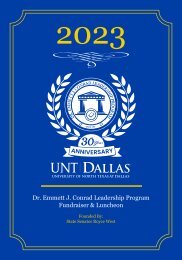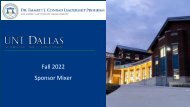UNT Dallas 2020 Master Plan
You also want an ePaper? Increase the reach of your titles
YUMPU automatically turns print PDFs into web optimized ePapers that Google loves.
spaces in the Lee F. Jackson building. The study<br />
identified specific space assignments for offices,<br />
classroom and instructional spaces, courtroom and<br />
advocacy training facilities, student life spaces, and<br />
experiential learning facilities, including a legal clinic.<br />
It also provided for the retention of the existing law<br />
library, the moot courtroom and a classroom and<br />
lab in the 1901 Main Street System building. Room<br />
utilization, planning test-fits, technical evaluations,<br />
historic considerations, and the renovation schedule<br />
were all addressed in the study.<br />
<strong>UNT</strong> <strong>Dallas</strong> CIP Proposed New Projects<br />
White Paper<br />
2017<br />
The Proposed New Projects White Paper<br />
recommended six priority projects to support the<br />
growing <strong>UNT</strong>-<strong>Dallas</strong> campus with a 21st-century<br />
learning environment. These projects comprised<br />
instructional facilities, including a 126,000 GSF<br />
STEM building and a 144,000 GSF business<br />
technology building, a 250-bed residence hall, a<br />
3,000-seat events center, a 1,000-space parking<br />
structure, and a centrally located landmark tower.<br />
<strong>Dallas</strong> Urban Heat Island Management Study<br />
2017<br />
The <strong>Dallas</strong> Urban Heat Island Management Study<br />
was one of the largest urban heat assessments in<br />
the United States. The study provided strategies to<br />
mitigate urban heat and identified the city's most<br />
vulnerable neighborhoods, several of which are<br />
those surrounding <strong>UNT</strong> <strong>Dallas</strong>.<br />
Smart Growth for <strong>Dallas</strong> Initiative<br />
2018<br />
The City of <strong>Dallas</strong> forms part of the <strong>Dallas</strong> Metroplex,<br />
one of the fastest growing metro regions in the<br />
United States. The city is a major economic center,<br />
but is also experiencing significant environmental<br />
and social challenges. The Trust for Public Land<br />
and supporting partners used geo-spatial data to<br />
study over 315,000 parcels of land in the city. The<br />
findings provided recommendations to improve<br />
the city's social, economic, and environmental<br />
resilience. Figure 2.4 displays the areas identified as<br />
priorities for health-promoting green infrastructure<br />
investments to address chronic health issues, such<br />
as respiratory disease, diabetes, and anxiety. Many<br />
of the communities west and south of downtown,<br />
including neighborhoods around the <strong>UNT</strong> <strong>Dallas</strong><br />
campus, fell into the "very-high" category for these<br />
conditions. These findings make evident the need<br />
for access to nature, recreational facilities, and other<br />
health-promoting amenities on the campus that may not<br />
otherwise be readily available to community residents.<br />
<strong>UNT</strong> <strong>Dallas</strong> Strategic <strong>Plan</strong>:<br />
Pathways to the Future<br />
2019<br />
The campus plan derived its basic foundation and<br />
guiding principles from this document, which outlined<br />
the university's mission, vision, values, and goals. The<br />
plan is described in Chapter 1.<br />
FIGURE 2.4: HEALTH PRIORITY AREAS<br />
IDENTIFIED BY THE TRUST FOR PUBLIC LAND<br />
1<br />
2<br />
1. <strong>UNT</strong> <strong>Dallas</strong> Main Campus<br />
2. <strong>UNT</strong> <strong>Dallas</strong> Law Center<br />
<strong>2020</strong> CAMPUS MASTER PLAN 20


















